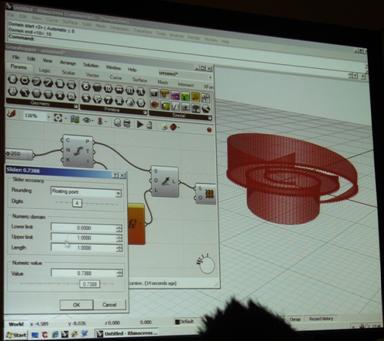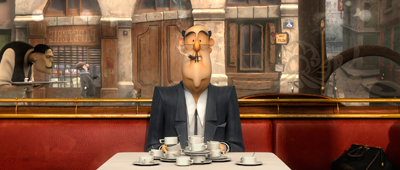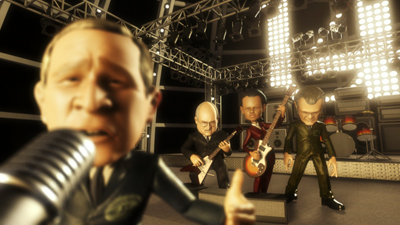|
SIGGRAPH 2009
By Fred Thorlin
Two trends stood out to me at this year’s SIGGRAPH convention held in New Orleans: node programming and free.
Illustration and 3D modeling are always the focus of SIGGRAPH. Ming Tang showed something new in the category. At earth.ming3d.com you can see his program that, from a general outline of zoning and terrain, produces a planned city, in detail, in AutoDesk Maya format, ready to fly through!
Autodesk now owns 3DS, SoftImage, AutoCAD and Maya, the major modeling packages. They are leading the way with implementing a node-based visual development environment. Several modeling systems now support this technique, e.g. SoftImage, Rhinoceros/Grasshopper and Blender. They also appear to be tinkering in the popular free market with web based applications. One is called Draw, Draw.labs.autodesk.com, which functions much likes Microsoft’s high priced Visio. Their Showroom is an innovative tool for the interior decorator showing color interactions from lighting using manufacturer’s actual products, from appliances to sofas; it even run on your iPhone, free.
Blender is an industrial strength 3D modeling and animation system incorporating the node programming method which is free for the downloading. It is open source and has a paid staff of two. Revenue comes from selling books on the product. Get it at blender.org.

Grasshopper is a free add-on to Rhinoceros. Rhinoceros is my preferred modeling tool and offers an excellent free trial. GrassHopper, grasshopper3d.com, uses node programming in a different way than the ones mentioned above in that the focus is more on leveraging math, in a way reminiscent of APL, than manipulating photorealistic images, but it works both ways. It looks like more fun.
Displays get wilder and wilder. The University of Koblenz reported an augmented reality headset for use underwater. They project images of fish and corals into a headset for snorkeling in a swimming pool. Kanagawa Institute showed a technology for producing 3D parallax over the internet using a barrier technology. Planar’ stereoscopic display cleverly uses two standard displays to achieve parallax. They use a polarized “mirror” to control which display each eye sees. The “mirror” does cause the loss of some brightness.
JVC has a display which supports the Real3D systems currently used in movie theaters. It produces a brilliant sharp display. They recommend it for use as an editing tool for movie editing. Slightly different, and more fun, is the DepthQ 3D projector. These devices are used in 3D cave displays; they project 3D images onto several walls of a room at once to create an alternate environment. They support OpenGL and DirectX on Nvidia cards. At $6K each they may be above your budget, but… they were using the Minoru 3D, two eyed, webcam for 3D capture; great fun for only $89. Minoru’s 3D signal requires the anaglyph glasses commonly used to read 3D comic books. Some come with the unit or you can go to Paper Optics, 3dglassesonline.com and get 3D glasses for many formats in popular use. While visiting take a look at their ChromaDepth glasses for something really different,
Two very nice input devices appeared at SIGGRAPH. One you can buy, the other you can’t… yet. Wacom’s new tablet/pen, the Intuos4, senses the pens orientation. The pressure sensitivity has been doubled so that soft pen strokes can be accurately captured. For the manual graphic artist working with a product like Fractal Paint this looks like a must have product. Prices are proportional to the tablet size. The tablet is exceptionally configurable through its driver by the end user. The buyer has a choice of several illustration products to be included with the tablet.
Touchco does not yet offer their multi-touch display overlay, but it is cool. There is no apparent limit to the number of contact points that can be simultaneously detected. Their locations and pressure levels are available to the driving application. Can you imagine clean finger painting? The range of information made available can seduce the developer into overkill. One of the demonstrations has you drawing with all of the fingers of one hand while simultaneously controlling color and sharpness with fiongers on the other; it made the point.
Once you have created the models, scenes, motions and such you want to tie them all together into a game to play on the Xbox, PlayStation, Wii, PC, Mac or internet. 3DVIA provides the tools to tie all of these components together and turn control of the hero over to the game controller. It accepts components from most major development tools.
Google has gotten into the act with O3D, an Open Source API for 3D modeling and interaction on the internet. It imports models from several major applications. You can see a demonstration of O3D at code.google.com/apis/o3d/. As you have come to expect from Google, it is free. All of this support for running in the browser has to be giving Microsoft a pain in the wallet.
3D printing still isn’t free, but the price is rapidly dropping. Last year Stratasys offered a desktop system for under $15,000. This year 3D Systems has a desktop printer for under $10,000. Their system uses a photo setting liquid instead of liquefying plastic.
It is very easy to get your own 3D model printed now. You usually create your model in STL format. Rhino, Solidworks, Maya, Max, Blender, AutoCAD, Pro Engineer and Daz, among others, produce this output format. Then send the file to a 3D print service; many are listed at wohlersassociates.com/service-providers.html . Shapeways is active in this business. They will make your object in plastic for $1.67/cc or in metal for $10/cc. You will receive your model in the mail ten days later. They also off some clever customizable products you can modify on their web site.
Historically the SIGGRAPH Animation Showcase has been where new artists strut there stuff. The film clips would run continuously for the length of the conference enabling each clip to appear more than once. Attendees would dive in between sessions to see what’s new. It is such a highlight that SIGGRAPH charges separately for it. Alas, most of this time is now occupied by presentations on a few of the clips from forthcoming motion pictures though the name and the price remain the same. There is no longer enough time to show or see the excellent submitted clips. I was not alone in my disappointment. Even so I saw some brilliant clips:
- Unbelievable Four – starring George, Dick, Condi and Don as rock star superheroes. Hilarious. Created by a Houston based artist but not generally available due to a music copyright issue.
- Live Music – Musical instruments after store hours. Stylish.
- Alma – A Spanish sweet, recursive, horror story about a child’s toy store.
- Pigeon: Impossible – The CIA challenges a bird and doesn’t do well.
- French Roast – a stylish, funny, five-minute, French farce.
- Who’s Gonna Save My Soul – by future shorts… you won’t believe what’s going to happen.
- Window Pains – by Bitfilm – everyman’s tech support call.

The last two are available full length on YouTube. Teasers are available there for some of the others. Live Music is the talk of Hollywood. This is a project that was organized through FaceBook. Animators from around the world worked together through Mass Animation to complete the film at a Hollywood beating cost. The look throughout is consistent and the quality is tops. If you have the skills you might look into freefac.org to get involved in another such project.

There were 29 companies, six foreign, at SIGGRAPH recruiting people with modeling skills. If you are a modeler its nice to know you are wanted. With the availability of free there is only effort between you and becoming one.

Fred Thorlin is a math tutor with experience in software development now working with Visual Basic and 3D modeling environments. He also writes columns on products and technologies that catch his interest. He can be contacted at Thorlin@swbell.net.

|

